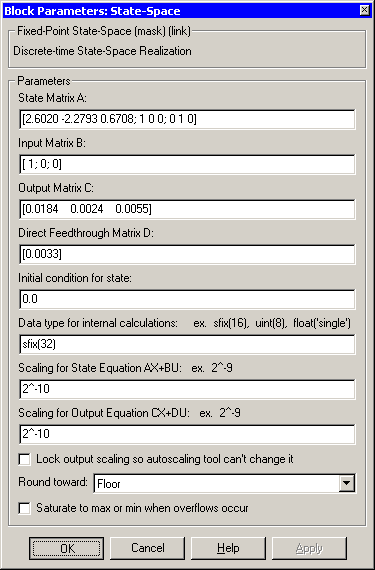| Fixed-Point Blockset |
  |
State-Space
Implement discrete-time state space
Library
Filters
Description

The State-Space block implements the system described by
where u is the input, x is the state, and y is the output. Both equations have the same data type.
The matrices A, B, C and D have the following characteristics:
- A must be an n-by-n matrix, where n is the number of states.
- B must be an n-by-m matrix, where m is the number of inputs.
- C must be an r-by-n matrix, where r is the number of outputs.
- D must be an r-by-m matrix.
In addition:
- The state x must be a n-by-1 vector
- The input u must be a m-by-1 vector
- The output y must be a r-by-1 vector
The block accepts one input and generates one output. The input vector width is determined by the number of columns in the B and D matrices. The output vector width is determined by the number of rows in the C and D matrices.
Parameters and Dialog Box

- State Matrix A
- Matrix of states.
- Input Matrix B
- Column vector of inputs.
- Output Matrix C
- Column vector of outputs.
- Direct Feedthrough Matrix D
- Matrix for direct feedthrough.
- Initial condition for state
- Initial condition for the state.
- Data type for internal calculations
- Data type for internal calculations. Some examples are
sfix(16), unit(8), and float('single').
- Scaling for State Equation AX+BU
- Scaling for state equations.
- Scaling for Output Equation CX+DU
- Scaling for output equations.
- Lock output scaling so autoscaling tool can't change it
- If the box is selected, the output scaling is locked.
- Round toward
- Rounding mode for the fixed-point output.
- Saturate to max or min when overflows occur
- If selected, fixed-point overflows saturate.
Characteristics
Input Ports
|
Any data type supported by the blockset--it must be a scalar
|
Output Port
|
Any data type supported by the blockset
|
Direct Feedthrough
|
Yes
|
Scalar Expansion
|
Of initial conditions
|
Vectorized
|
No
|
 | Sine | | Subtract |  |






